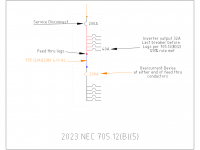Say you have a 200A meter/main, 200A bus bar with feed thru lugs.
The existing feeder is 4/0 AL XHHW-2, the sub panel has a 200A main.
And we want to add a inverter with a 32 amp nameplate.
705.12(B)(5) says the feed-through conductors (feeder) needs to be sized per 705.12(A),
705.12(A)(1) is met.
Next we have 705.12(A)(2)
We can choose a or b
705.12(A)(2)(a) says the ampacity in this case would need to be 100% of the main + 125% of the inverter; 200 + 40 = 240A (350kcmil AL)
705.12(A)(2)(b) says we can have a main breaker in the sub panel not greater than the ampacity of the feeder.
705.12(A)(2)(b) does not contain any next standard size up language, so the breaker for the 4/0 AL would need to be 175A ?
Diagram attached

Any thoughts?
The existing feeder is 4/0 AL XHHW-2, the sub panel has a 200A main.
And we want to add a inverter with a 32 amp nameplate.
705.12(B)(5) says the feed-through conductors (feeder) needs to be sized per 705.12(A),
705.12(A)(1) is met.
Next we have 705.12(A)(2)
We can choose a or b
705.12(A)(2)(a) says the ampacity in this case would need to be 100% of the main + 125% of the inverter; 200 + 40 = 240A (350kcmil AL)
705.12(A)(2)(b) says we can have a main breaker in the sub panel not greater than the ampacity of the feeder.
705.12(A)(2)(b) does not contain any next standard size up language, so the breaker for the 4/0 AL would need to be 175A ?
Diagram attached

Any thoughts?

